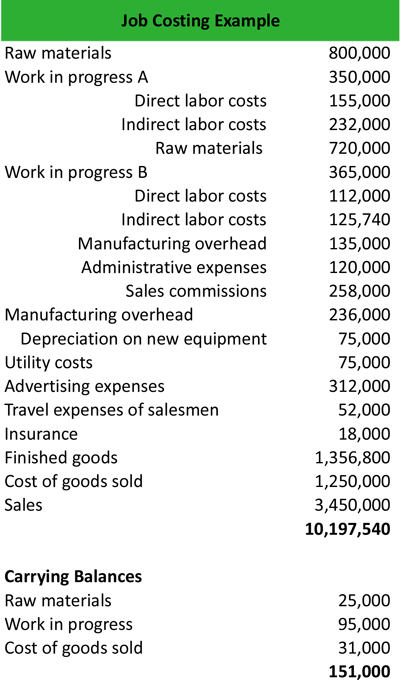5 1: Compare and Contrast Job Order Costing and Process Costing Business LibreTexts

If your company sold the same product to every customer, you would only need to do this once since your costs would be the same for each item. Because your company provides a unique product or service to each customer, however, you need to complete this process for each order. This requires medical service businesses and other service companies to keep detailed records of each specific job to determine costs correctly. For example, a doctor’s office may order patients based on the purpose of visits and the cost of treatments administered. Wood and fastener metals are typically added at the beginning of the process and are easily tracked as direct material.
Evaluating Batch Production: Job or Process Costing?
There are many other cost accounting methods, such as standard costing, marginal costing, and absorption costing. Aligning capabilities with costing approach gives strategic advantage. Job order costing provides customizable cost control for low-volume complexity. Process costing simplifies assumptions for mass production scale and consistency. Manual accounting is becoming outdated and inefficient, hindering business growth and profitability. According to Gartner, more than 59% of accountants make financial errors several times monthly.
How Often Do Companies Use Their Job Order Costing Systems?
The number of direct labor hours used on the jobs is the basis of such allocation. Using job order costing to determine the profitability of each project gives you valuable insight into the value of each client and can help you package and price your services. These professionals also allocate indirect costs like office rent and utilities to each job. This could lead to overcharging one customer and losing money on another.
Do you already work with a financial advisor?
Using job order costing over time will develop a historical record of all projects you’ve completed. This information can be revisited monthly, quarterly, and yearly to evaluate the company’s efficiency and identify areas to reduce costs. This system helps businesses understand the cost of specific jobs so they can set prices and manage money better.
Calculating the costs
The job cost sheet can be used to evaluate the costs and profitability and determine whether the job meets its objectives. It can also be used to compare how much different jobs cost and determine how well the production process works. In summary, ABC offers the most granular cost analysis while process costing optimizes for volume efficiency. Activity-based costing (ABC) assigns overhead and indirect costs to specific activities rather than products. Costs of materials, salaries, equipment usage are collected and divided by the total output of each chemical produced. This total cost is attached to the units produced and carried forward to ending inventory.
What is the major difference between job order and process costing?
They’re provided as an estimate, and should be adjusted in the final stages of production based on any additional indirect costs which add up during the production process. These costs include the cost of manufacturing equipment, the electricity used to run the equipment, utility bills, and depreciation of machines. In service-based businesses, where direct labor is the most substantial cost, time tracking based on predetermined rates is essential for successfully implementing a job order costing system.
Gordian created Job Order Contracting (JOC) and the industry-standard RSMeans Data. We empower organizations to optimize capital investments, improve project performance and minimize long-term operating expenses. With processing, it is difficult to establish how much of each material, and exactly how much time is in each unit of finished product. This will require the use of the equivalent unit computation, and management selects the method (weighted average or FIFO) that best fits their information system. If you are considering implementing a job order costing system in your business, several professionals can help you get started. The best way to choose a cost accounting system is to consider the specific needs of your business.

At the beginning of the period, the total amount of manufacturing overhead costs are estimated based on historical data and current year production estimates. Throughout the year, the total amount of estimated manufacturing overhead is uniformly applied to the jobs in process using some type of allocation base or cost driver. An allocation base or cost driver is a production activity that drives costs. Common allocation bases are direct labor hours, machine hours, direct labor dollars, or direct materials dollars.
- How does a company differentiate between direct and indirect material?
- The physical materials needed to support the execution of services (such as paper, printer ink, or a laptop) are indirect materials and are considered overhead costs.
- This costing method is essential for industries that produce custom-made products or services, as each order requires specific materials, labor, and overhead expenses.
- The company allocates overhead costs to jobs at a rate of 35% of total direct labor cost incurred.
Doing so provides consistent and comparable costing from one batch to the next. In summary, job order costing suits low-volume, customized production while process costing fits high-volume, standardized output. The key determinant is the level of customization and volume of production. In summary, job order costing tracks costs for specialized jobs, while standard costing sets standard costs for identical units. Job order costing values inventory uniquely, standard costing uses averages.
While making drumsticks may sound simple, an immense amount of technology is involved. Rock City Percussion makes \(8,000\) hickory sticks per day, four days each week. The sticks made of maple and birch are manufactured turbotax live 2021 on the fifth day of the week. It is difficult to tell the first drumstick made on Monday from the \(32,000\)th one made on Thursday, so a computer matches the sticks in pairs based on the tone produced.
